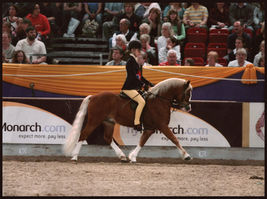Welsh Section A
THE WELSH MOUNTAIN PONY
Not exceeding 121.9 cm (12.0 hands)
Section A of the Stud Book
General Character
Hardy, spirited and pony-like
Colour
Any colour, except piebald and skewbald
Head
Small, clean-cut, well set on and tapering to the muzzle
Eyes
Bold
Ears
Well placed, small and pointed, well up on the head, proportionately close
Nostrils
Prominent and open
Jaws and Throat
Clean and finely-cut, with ample room at the angle of the jaw
Neck
Lengthy, well carried and moderately lean in the case of mares, but inclined to be cresty in the case of mature stallions
Shoulders
Long and sloping well back. Withers moderately fine, but not "knifey". The humerus upright so that the foreleg is not set in under the body.
Forelegs
Set square and true, and not tied in at the elbows. Long, strong forearm, well developed knee, short flat bone below knee, pasterns of proportionate slope and length, feet well-shaped and round, hoofs dense.
Back and Loins
Muscular, strong and well coupled
Girth
Deep
Ribs
Well sprung
Hind Quarters
Lengthy and fine. Not ragged or goose-rumped. Tail well set on and carried gaily.
Hind Legs
Hocks to be large, flat, and clean with points prominent, to turn neither inwards nor outwards. The hind legs not to be too bent. The hock not to be set behind a line from the point of the quarter to the fetlock joint. Pasterns of proportionate slope and length. Feet well-shaped, hoofs dense.
Action
Quick, free and straight from the shoulder and hocks well flexed with straight and powerful leverage and well under the body.
History
Descending from the indigenous native ponies that have been inhabiting the uplands of the Principality for thousands of years, the smallest of the Welsh sections has developed a strong constitution, a great intelligence and determined nature. More recent refinements included the introduction of Arabian and Thoroughbred bloodlines during the 19th century and before the formation of the Stud Book Society. After the formation of the Welsh Pony and Cob Society and subsequent definitions of the Welsh Stud Book sections, the Welsh Mountain Pony Section A was split into two types. Part I was a lighter, more refined pony up to 12hh, and Part II was for a heavier, more 'cobby' type of pony that could be up to 12.2hh and would often be hogged and docked. Later on, this description was redefined, and the height limit was fixed at 12hh, with docking and hogging no longer allowed.
Uses
Throughout the last 100 years, the use of the Welsh Mountain Pony has often been geared towards a riding pony for the youngest riders, due to their size, good nature and quality, refined characteristics. Indeed, the Welsh Mountain Pony is often said to be the world's most beautiful pony. They have proved to be capable mounts for the youngest riders first learning the ropes, and will excel at all disciplines, from teaching the child how to ride to taking their riders through Pony Club and on into the performance sphere, to dressage, jumping and showing. Many a Welsh Mountain Pony has made their young jockey's dream come true with success at world famous events such as HOYS.












